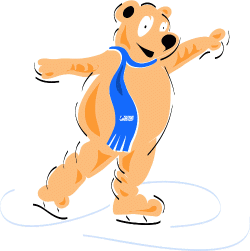Warwick Figure Skaters' Learn to Skate Program

Basic Skills Learn-to-Skate Program - Warwick Figure Skaters proudly participates in the United States Figure Skating (USFS) Learn-to-Skate Program.
This program is designed to teach the beginner skater all the fundamentals of figure skating while having fun on the ice. It is designed to keep skaters enthusiastic from the time they first step onto the ice to begin their lessons until the time they reach their goal, whether you want to be an Olympic or national champion, compete in local competitions or just enjoy the recreational skating, the USFS Basic Skills Program is for you!
 Ice skating is a great way to have fun while doing something that is good for you -- skating builds muscles, stimulates your heart and builds coordination and balance. You can do it with all your family and friends. It's a great sport no matter what your age and it's never to late to learn.
Ice skating is a great way to have fun while doing something that is good for you -- skating builds muscles, stimulates your heart and builds coordination and balance. You can do it with all your family and friends. It's a great sport no matter what your age and it's never to late to learn.
There are currently more than 800 Basic Skills programs with over 100,000 skaters registered in the USFS Basic Skills Program.
The objectives of this program are:
- to provide a fun and safe skating experience for the beginner skater as well as the more advanced skater
- teach correct technique of the basic elements of skating
- develop a finer degree of balance and coordination
- promote physical fitness
- and HAVE FUN!!
As a member of our club's USFS Basic Skills program, you will receive great instruction from our excellent coaching staff and:
- an official USFS Basic Skills membership card
- a USFS Basic Skills Program book with fun stickers to track your progress as you continue to skate
- official USFS Basic Skills membership and year patches
- sports accident insurance coverage
- general information about figure skating
How Do You Get Started?
You need to register for one of our Basic Skills sessions, which are offered three times during the year:
- Fall/Winter - which normally begins the weekend after Columbus Day and runs until the end of February. Registration is held in September and October
- Spring - which runs during May and June. Registration is held in April
- Summer - which runs during July and August. Registration is held in June
CHECK THE WFS WEBSITE FOR APPLICATIONS AND FURTHER INFORMATION.
For further information on our program, please contact Katie McKenzie at Katielmc@aol.com.
Equipment - What Will I Need?
- Dress warm with layers (fleece, sweatpants/fleece pants, sweater)
- Mittens
- Safety helmets or bike helmets for younger, beginner skaters
- Socks: your feet will feel best if you wear one pair of lightweight socks or tights. Bulky or thick socks limit support and can create "lumps and bumps" inside your skates that can cause your feet to hurt or cause blisters.
- Skates
What Do I Need to Know about Skates?
- The boot should provide a snug fit but with enough room to move your toes when properly laced.
- Boots should be made of a firm material, preferably top grain leather, to provide good ankle support.
- Hooks and eyelets should be firmly attached and the boot fully lined.
- If the boot is too small, OUCH!
- If the boot is too big, it will not provide the necessary support.
- Blades should be stainless steel so they can be kept properly sharpened and hold an edge.
- They should be properly mounted on the boot with screws.
New Skates vs. Used Skates vs. Rental Skates??
It is not necessary to buy new skates. Used skates can be a great bargain if you know what to look for. Some rinks and skating clubs occasionally hold skate re-sales--check the bulletin board at the rink for skates for sale. Look for clean, firm leather boots that are fully lined. Check the blades for deep nicks and scratches and make sure they still have enough "life" for future sharpenings. If you are unsure of the condition of a pair of skates, ask your skating instructor for tips. Many local shops also carry used skates that are in good condition.
If you decide to buy new skates, ask your instructor for the names of skate manufacturers and local skate shops that carry figure skates. Local shops carry many brands and models of beginner skates in their shop or can order them directly from the manufacturer.
Rental skates are always a good option, especially with young, beginner skaters who's feet grow fast! When renting skates, ask for a pair with firm boots and sharp blades. Local shops will often provide you with rental skates by the week or by the season.
Proper Lacing
- Loosen the laces, pull the tongue forward and insert your foot into the boot.
- Center the boot tongue and pull it up.
- Tighten the laces through the eyelets so they are snug (no slack) but not too tight.
- To insure proper support for the ankles, the tightest point of lacing should be at the instep.
- Follow by criss-crossing the laces snugly around each hook.
- When you reach the top, tie a secure bow.
- If the ends are too long, wrap the laces through the hooks again and then tie a bow in front.
- Do not let the ends of the laces drag on the ice.
- A good fit will allow you to insert a finger in the back of your boot.
Let's Go Ice Skating and remember--Have lots of fun!!
| Attachment | Size |
|---|---|
| 1.02 MB |

